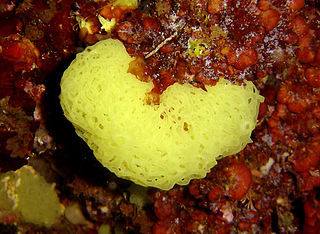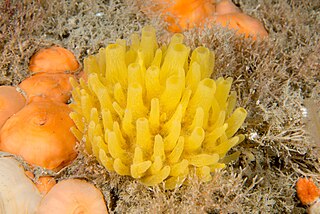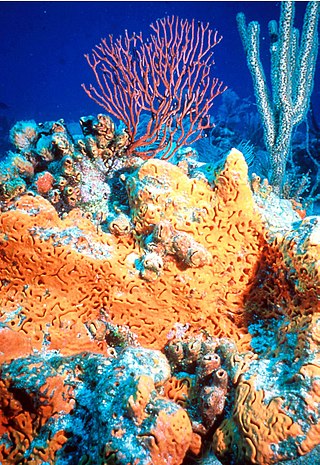
Cladorhiza is a genus of carnivorous sponges, comprising around 40 species found in oceans around the world. Cladorhiza is the type genus of the family Cladorhizidae.

Clathrina is a genus of calcareous sponge in the family Clathrinidae. Several species formerly in Clathrina were transferred to the newly erected genera Arturia, Ernstia, Borojevia, and Brattegardia in 2013. The name is derived from the Latin word "clathratus" meaning "latticed".

Grantia is a genus of calcareous sponges belonging to the family Grantiidae. Species of the genus Grantia contain spicules and spongin fibers.

Polymastia is a genus of sea sponges containing about 30 species. These are small to large encrusting or dome-shaped sponges with a smooth surface having many teat-shaped projections (papillae). In areas of strong wave action, this genus does not grow the teat structures, but instead grows in a corrugated form.

Halichondriidae is a family of sea sponges belonging to the order Suberitida. These sponges have a skeleton consisting of dense bundles of spicules occurring in a more or less random pattern.

Tetillidae is a family of marine sponges. Tetillids are more or less spherical sponges which are found commonly in all marine habitats at all depths throughout the world. They are especially common in sedimented habitats. Over a hundred species have been described in ten genera.

Homosclerophorida is an order of marine sponges. It is the only order in the monotypic class Homoscleromorpha. The order is composed of two families: Plakinidae and Oscarellidae.

Axinellidae is a family of sponges in the order Axinellida.
Halichondria bowerbanki, commonly known as the yellow sun sponge, is a species of sea sponge in the family Halichondriidae. It is found on rocky surfaces in the shallow subtidal, with occasional intertidal specimens under overhanging rocks. The physical appearance and structure of the species is variable and it has tassel-like irregular branches. Colonies can be up to 25 centimeters high with branches reaching 12 centimeters high. The color of the species is beige to brown in the summer, and light grey/yellow in the winter.
Ascandra izuensis is a species of sea sponge in the family Clathrinidae. The species is named after the Izu peninsula where the holotype was collected.
Clathrina multiformis is a species of calcareous sponge from Russia.
Thoosa is a genus of sea sponges in the family Thoosidae. This genus is known for boring holes in corals. It contains sixteen described species.
Pseudospongosorites is a genus of sea sponges belonging to the family Suberitidae. Currently, the genus is considered as monotypic, consisting of a single species Pseudospongosorites suberitoides. It is found in the Caribbean Sea, the Gulf of Mexico and on the Atlantic coast of the United States as far north as North Carolina. This species is known by the common name Florida hermit crab sponge, so named because hermit crabs often use it as shelter.

Pachymatisma is a genus of sponges belonging to the family Geodiidae.

Agelas is a genus of sea sponge in the class Demospongiae.
Guancha apicalis was thought to be a species of calcareous sponge in the genus Guancha from Antarctica. It actually never existed.

Mycale is a genus of demosponge with 240 recognised species in 11 subgenera. It has been a large genus with multiple subdivisions since it was first described in 1867.

Leucetta chagosensis is a species of calcareous sponge in the family Leucettidae, and was first described in 1913 by Arthur Dendy. The species epithet, chagosensis, comes from the Latin with the ending -ensis indicating that the species comes from the Chagos Archipelago in the Indian Ocean. The taxonomic decision for synonymy is based on Maurice Burton (1963).

Advhena is a monotypic genus of glass sponges in the family Euplectellidae. It contains the single species Advhena magnifica, also known as the E.T. sponge, after the titular character in the film E.T. the Extra-Terrestrial.












